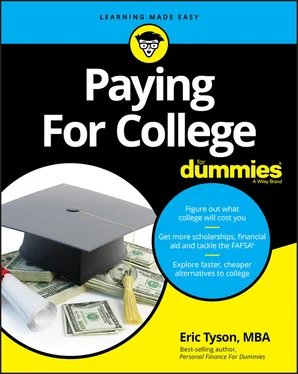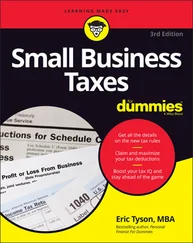3 Part 1: Understanding Paying for College Part 1
Chapter 1: Confronting High College Prices and the Modern Job Market Chapter 1
Confronting the High Prices of Higher Education Confronting the High Prices of Higher Education Okay, let’s get the bad news out of the way. Yes, college is expensive. Consider the supposedly “best” private colleges which on most lists includes colleges and universities like Brown University, Carnegie Mellon University, Colgate University, Columbia University, Cornell University, Dartmouth College, Duke University, Georgetown University, Harvard University, Johns Hopkins University, Lehigh University, MIT, Northwestern University, Princeton University, Rice University, Stanford University, Tufts University, University of Chicago, University of Notre Dame, University of Pennsylvania, University of Southern California, Vanderbilt University, Washington & Lee University, Washington University, and Yale University. Tuition, room, board, books, and other fees will run you $250K to $300K or more over four years! Stop and think about that high cost for a moment. If that’s not daunting enough, getting into these schools is ridiculously difficult and competitive to do. High school students are packing their schedules with Advanced Placement and honors courses, burning the midnight oil to get that elevated grade point average, playing sports, running for student government, playing in the band, volunteering regularly and jumping through other hoops. In the hopes of making their future college applications tempt admissions officers, students must also often seek other ways to stand out and be different. Being from a small state, rural or non-wealthy area certainly helps. Living in a non-wealthy area and attending a not so great public school may help your case also. While quite a bit less expensive if you qualify for in state tuition rates, public colleges are getting more and more expensive and can easily set you back for well over $100K for a four-year education. If you attend a top public college as an out of state resident, expect to pay upwards of $200K for the four years — about the same freight as those going to a typical private college. Looking back over the past 50 years, after adjusting for increases in the general cost of living, tuition and fees at four-year colleges have jumped in real terms (that is, above and beyond the general rise in the cost of living) by more than 240 percent at private colleges and 340 percent at public colleges according to data from the National Center for Education Statistics. This trend obviously can’t continue because few families can afford to pay the already big dollar amounts today.
Looking at How College Pricing Works Looking at How College Pricing Works Now, time for some better news. Despite having dropped a bunch of respected college names on you earlier in this chapter that most people believe are “top” or “premier” colleges, I’m not suggesting that you need to attend a brand-name college and spend hundreds of thousands of dollars for your child to get a great higher education. You and they don’t have to do that in order to find a fulfilling job or career with good compensation. Even if you do aspire to a costly private college for your offspring, you should know that the average price that colleges typically charge and collect from each family equals about half of the stated full cost of attendance. So, for example, with private colleges charging around $60K per year the average family is actually paying about half of that or $30K. This happens due to “financial aid,” which is another way of saying that a college or university will charge you and your family less the less able they deem you to pay the full retail price. High-income and affluent families generally pay full price or near full price unless their son or daughter qualifies for some sort of athletic or merit-type scholarship (price reduction). Some colleges, for example, Ivy League colleges, don’t offer these types of scholarships and only offer so-called need-based scholarships (price reductions). Check out Chapter 11 for more on scholarships.
Employment Reality and What Students Say They Want from College Looking at How the Higher Education Landscape is Changing Chapter 2: Financial Planning Steps When Your Kids are Young Kids Are Costly! Getting Your Finances in Order Finding Saving Methods Given How College Financial Aid Works Spending on Your Kids without Breaking the Bank Keeping Spending in Line: Using Youth Sports as an Example Completing the Personal Finance Olympics of Childrearing Chapter 3: Exposing Your Kids to Work, Finances, and the “Real World” Laying the Foundation for Raising Money-Smart Kids in the Early Years Dealing with What Kids Are Exposed To Developing the Work-Money Connection Teaching Your Kids About More Real-World Money Topics
4 Part 2: Finding Acceptance Chapter 4: Making the Most of Your Kid’s Academic and Outside Experiences Understanding the Value of Academic Success (Good Grades) Jumping Through Hoops: Marketing of High School Students Chapter 5: Guiding Your Child Agreeing to a Process for Making Decisions Conducting the Right Research Working with and Hiring “Experts” Dealing with Mental Health Issues
5 Part 3: Confronting College Costs: Traditional Colleges and Alternatives Chapter 6: Seeing How Traditional Colleges Decide What to Charge You Taking All Your (Financial) Clothes OFF! Valuing Wanting One Another Checking on Realities for Recruited Athletes Chapter 7: Surveying the Range of College Options Considering Four-Year Colleges Learning and Serving in the Military Considering Community Colleges Taking a Year Post–High School to Work or Volunteer Is College Necessary or the Best Option for Your Children? Chapter 8: The Best College Alternatives to Consider Looking at Last-Mile Programs Getting Oriented with Online Programs Finding Out about Vocational/Trade Schools Final Thoughts on Alternatives to Traditional Colleges
6 Part 4: Getting the Best Education at the Best Price Chapter 9: Financial Steps You Should Take While Your Kids Grow Up Determining a College Financial Aid Package Looking into Long-Term Saving and Investing Strategies Strategizing to Pay for Educational Expenses Determining Later-Year Savings Tactics Chapter 10: Filling Out the Common Financial Aid Forms to Your Best Advantage Determining Whether to Apply for Financial Aid Taking an Overview of Financial Aid Forms Filling Out the FAFSA® Form: Free Application for Federal Student Aid Getting on Board with the CSS Profile Form Checking Off School-Specific Forms Chapter 11: Tricks and Tips for Finding Scholarships and Borrowing Money Gaining Grants and Scholarships Borrowing for College Chapter 12: Reviewing Financial Aid Offers and Appealing Them Getting Word on College Acceptances and Doing More Research Taking a Long, Hard Look at the Bottom-Line Price
7 Part 5: The Part of Tens Chapter 13: (Almost) Ten Education Tax Breaks and Rules You Should Know About Contributing to Retirement Accounts Checking to See if You Qualify for the Saver’s Tax Credit Understanding the Tax Benefits of 529 Plans Considering Coverdell Education Savings Accounts (ESAs) Utilizing the American Opportunity Tax Credit Taking Advantage of the Lifetime Learning Credit Understanding the Retirement Account Withdrawal Penalty Waiver Finishing on Time without High Income Earning Years Taking the Student Loan Interest Deduction Chapter 14: Ten Tips for Getting Your College Degree Quicker Communicating Is Key Keeping All Your Options Open Planning Ahead Financially Picking Colleges with High Graduation Rates Selecting Colleges that Offer Your Desired Courses and Majors Choosing Schools with Affordable Housing Getting College Credit in High School Making Use of Advisors and Deans Having Students Work during College Avoiding Stopping School to Work Chapter 15: Ten Important Money Management Steps for Young Adults Getting Financially Fit, Now! Adapting and Adjusting Along the Way Cancelling Consumer Credit Reviewing Your Budget and Spending Plans Striving to Regularly Save and Invest Ensuring that You’re Properly Insured Continuing Your Education Always Being Prepared for a Job Change Evaluating the Total Cost of Relocating Ensuring Compatibility when Picking a Partner Chapter 16: Ten Things to Know About Student Loans Keeping Track of Your Loans Understanding What Cosigners Means for Responsibility Knowing the Loan Terms Using the Auto-Pay Feature to Save Money Understanding Loan Forgiveness Conditions Knowing Your Federal Loan Repayment Options Cautiously Considering Refinance Possibilities Asking for Relief Making Use of the Student Loan Interest Deduction Pausing Your Loans with a Return to Higher Education
Читать дальше












